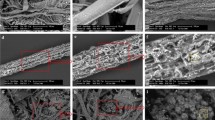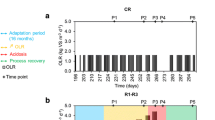Abstract
In this study, denitrification of ammonium-reach anaerobic sludge digester liquor was investigated during start-up periods of two laboratory-scale “fill-and-draw” reactors. One reactor was fed with a single carbon source (ethanol), whereas the other reactor was fed with a complex carbon source (fusel oil). During two acclimation experiments, the structure of microbial community involved in denitrification was analyzed using 16S rDNA polymerase chain reaction-denaturing gradient gel electrophoresis fingerprints and fluorescent in situ hybridization. The characteristics of the mixed liquor were additionally supported by regular measurements of nitrate uptake rates. The addition of fusel oil and ethanol resulted in a significant enhancement of the denitrification rate and efficiency combined with the increasing volumetric addition of sludge digester liquor up to 15 % of the reactor volume. The microbiological analyses revealed that the addition of sludge digester liquor as well as both external carbon sources (fusel oil and ethanol) did not affect the structure of microbial communities in a severe way. In both reactors, Curvibacter sp. and Azoarcus sp. were found as the most abundant representatives of denitrifiers.



Similar content being viewed by others
Abbreviations
- COD:
-
Chemical oxygen demand
- FISH:
-
Fluorescent in situ hybridization
- HRT:
-
Hydraulic retention time
- MLVSS:
-
Mixed liquor volatile suspended solids
- MLSS:
-
Mixed liquor suspended solids
- NUR:
-
Nitrate uptake rate
- PCR-DGGE:
-
Polymerase chain reaction-denaturing gradient gel electrophoresis fingerprints
- SRT:
-
Sludge retention time
- TN:
-
Total nitrogen
- WWTP:
-
Waste water treatment plant
References
Altschul SF, Madden TL, Schaffer AA, Zhang J, Zhang Z, Miller W, Lipman DJ (1997) Gapped BLAST and PSI-BLAST: a new generation of protein database search programs. Nucleic Acids Res 25:3389–3402
Alvarez PJJ, Hunt CS (2002) The effect of fuel alcohol on monoaromatic hydrocarbon biodegradation and natural attenuation. Rev Latinoam Microbiol 44:83–104
Czerwionka K, Makinia J, Pagilla KR, Stensel HD (2012) Characteristics and fate of organic nitrogen in municipal biological nutrient removal wastewater treatment plants. Water Res 46:2057–2066
Dionisi D, Renzi V, Majone M, Beccari M, Ramadori R (2004) Storage of substrate mixtures by activated sludges under dynamic conditions in anoxic or aerobic environments. Water Res 38(8):2196–2206
Fux C, Lange K, Faessler A, Huber P, Grueniger B, Siegrist H (2003) Nitrogen removal from Digester Supernatant Via Nitrite-SBR or SHARON? Water Sci Technol 48:9–18
Fux C, Velten S, Carozzi V, Solley D, Keller J (2006) Efficient and stable nitritation and denitritation of ammonium-rich sludge dewatering liquor using an SBR with continuous loading. Water Res 40:2765–2775
Hagman H, Nielsen JL, Nielsen PH, la Jansen Cour J (2008) Mixed carbon sources for nitrate reduction in activated sludge-identification of bacteria and process activity studies. Water Res 42:1539–1546
Hallin S, Pell M (1998) Metabolic properties of denitrifying bacteria adapting to methanol and ethanol in activated sludge. Water Res 32:13–18
Hallin S, Throbäck IN, Dicksved J, Pell M (2006) Metabolic profiles and genetic diversity of denitrifying communities in activated sludge processes after addition of methanol or ethanol. Appl Environ Microbiol 72:5445–5452
Hiraishi A, Khan ST (2003) Application of polyhydroxyalkanoates for denitrification in water and wastewater treatment. Appl Microbiol Biotechnol 61:103–109
Juretschko S, Loy A, Lehner A, Wagner M (2002) The microbial community composition of a nitrifying-dentrifying activated sludge from an industrial sewage treatment plant analyzed by the full-cycle rRNA approach. Syst Appl Microbiol 25:84–89
Makinia J, Czerwionka K, Oleszkiewicz J, Kulbat E, Fudala-Ksiazek S (2011) A distillery by-product as an external carbon source for enhancing denitrification in mainstream and sidestream treatment processes. Water Sci Technol 64:2072–2079
Makinia J, Czerwionka K, Kaszubowska M, Majtacz J (2014) Distillery fusel oil as an alternative carbon source for denitrification – from laboratory experiments to full-scale applications. Water Sci Technol 69:1626–1633
Malá J, Malý J (2010) Wastewater from biodiesel production as a carbon source for denitrification of sludge liquor in SBR. Chem Biochem Eng Q 24(2):211–217
Mechichi T, Stackebrandt E, Gad’on N, Fuchs G (2002) Phylogenetic and metabolic diversity of bacteria degrading aromatic compounds under denitrifying conditions, and description of Thauera phenylacetica sp. nov., Thauera aminoaromatica sp. nov., and Azoarcus buckelii sp. nov. Arch Microbiol 178:26–35
Muyzer G, Brinkhoff T, Nübel U, Santegoeds C, Schäfer H, Wawer C (2004) Denaturing gradient gel electrophoresis (DGGE) in microbial ecology. Mol Microb Ecol Man 1 and 2:743–769
Nei M, Li WH (1979) Mathematical model for studying genetic variation in terms of restriction endonucleases. Proc Natl Acad Sci USA 76:5269–5273
Nielsen PH, Lemmer H, Daims H (Eds.) (2009) In: Identification and quantification of microorganisms in activated sludge and biofilms by FISH. FISH Handbook of wastewater treatment (1 ed.) IWA Publishing Company New York
Nübel U, Engelen B, Felske A, Snaidr J, Wieshuber A, Amamm RI, Ludwig W, Backhaus H (1996) Sequence heterogeneities of genes encoding 16 rRNAs in Paenibacillus polymyxa detected by temperature gradient gel electrophoresis. J Bacteriol 178:5636–5643
Osaka T, Yoshie S, Tsuneda S, Hirata A, Iwami N, Inamori Y (2006) Identification of acetate- or methanol-assimilating bacteria under nitrate-reducing conditions by stable-isotope probing. Microb Ecol 52:253–266
Poulsen LK, Ballard G, Stahl DA (1993) Use of rRNA fluorescence in situ hybridization for measuring the activity of single cells in young and established biofilms. Appl Environ Microbiol 59:1354–1360
Queiroz LM, Aun MV, Morita DM, Alem Sobrinho P (2011) Biological nitrogen removal over nitritation/denitritation using phenol as carbon source. Braz J Chem Eng 28(2):197–207
Song B, Palleroni NJ, Kerkhof LJ, Haggblom MM (2001) Characterization of halobenzoate-degrading, denitrifying Azoarcus and Thauera isolates and description of Thauera chlorobenzoica sp. nov. Int J Syst Bacteriol 51:589–602
Thompson JD, Higgins DG, Gibson TJ (1994) CLUSTAL in: improving the sensitivity of progressive multiple sequence alignment through sequence weighting, positions-specific gap penalties and weight matrix choice. Nucleic Acids Res 22:4673–4680
Thomsen TR, Kong Y, Nielsen PH (2007) Ecophysiology of abundant denitrifying bacteria in activated sludge. FEMS Microbiol Ecol 60:370–382
van Hannen EJ, Zwart G, van Agterveld MP, Gons HJ, Ebert J, Landbroek HJ (1999) Changes in bacterial and eukaryotic community structure after mass lysis of filamentous cyanobacteria asociated with viruses. Appl Environ Microbiol 65:795–801
von Wintzingerode VF, Göbel UB, Stackebrandt E (1997) Determination of microbial diversity in environmental samples: pitfalls of PCR-based rRNA analysis. FEMS Microbiol Rev 21:213–229
Wright ES, Safak Yilmaz L, Noguera DR (2012) DECIPHER, a search-based approach to chimera identification for 16S rRNA sequences. Appl Environ Microbiol 78:3717–3725
Acknowledgments
This study was financially supported by European Regional Development Fund within the framework of the Innovative Economy Operational Programme 2007–2013 under the project no. UDA-POIG.01.03.01–22-140/09-04.
Author information
Authors and Affiliations
Corresponding author
Electronic supplementary material
Below is the link to the electronic supplementary material.
Rights and permissions
About this article
Cite this article
Czerwionka, K., Luczkiewicz, A., Majtacz, J. et al. Acclimation of denitrifying activated sludge to a single vs. complex external carbon source during a start-up of sequencing batch reactors treating ammonium-rich anaerobic sludge digester liquors. Biodegradation 25, 881–892 (2014). https://doi.org/10.1007/s10532-014-9707-0
Received:
Accepted:
Published:
Issue Date:
DOI: https://doi.org/10.1007/s10532-014-9707-0




